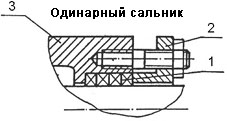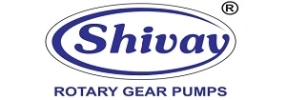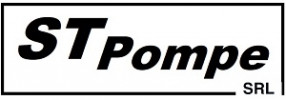|
 This is one of the simplest and most inexpensive shaft seals, which has been used for centuries and is still in use. This is one of the simplest and most inexpensive shaft seals, which has been used for centuries and is still in use.
Structurally, it is a cord 1 that fits into the groove of the pump housing 3 around the shaft and is pressed in some way (sealed stuffing box cover 2, which is tightened with screws to the pump housing).
The name "gland packing" has been preserved since the time when a rope impregnated with grease served as a sealing cord.
Currently, special cords are used for sealing this type, made of various materials and impregnated with special impregnations, depending on on the pumped liquid and operating temperature.
|
|
 These seals can work if the packing is constantly in a wet state, for which it is tightened to such a state that liquid drips through it when the pump is running. If the packing is overtightened, it can overheat the stuffing box and destroy the packing. In this connection, such a seal cannot guarantee complete tightness. These seals can work if the packing is constantly in a wet state, for which it is tightened to such a state that liquid drips through it when the pump is running. If the packing is overtightened, it can overheat the stuffing box and destroy the packing. In this connection, such a seal cannot guarantee complete tightness.
Single stuffing box packing and double stuffing box are used.
Single stuffing box works with liquids up to +95°C, double stuffing box works up to +140°C and more.
A feature of the operation of a double stuffing box is the need to supply barrier fluid to the chamber between seals. In this case, the barrier liquid pressure should be 0.5 atm higher than the pressure in the pump section. The figure shows the arrangement of a double gland seal.
|
|
Types of packing:
- graphite, based on reinforced foil section from 3mm to 50mm
Such gland packings have high elasticity, good ductility during compression, have a low coefficient of friction, high thermal conductivity, exclude corrosion and mechanical wear of the working surface.
Applied for use in water pumps.
- made of synthetic fibers section from 3mm to 50mm
Packings made of synthetic fibers have high mechanical strength and resistance to abrasive media. They are recommended for use in the oil refining, chemical, pulp and paper industries.
- fluoroplastic (based on expanded fluoroplast) section from 3mm to 50mm
fluoroplastic packings are resistant to aggressive environments, practically do not have cold fluidity, are very plastic during compression. They are recommended for use in the pharmaceutical, food, pulp and paper, chemical industries.
The exception is fluorine-containing liquids.
- fluoroplastic graphite-filled (based on expanded graphite-filled fluoroplast) section from 3mm to 50mm
Graphite-filled gland packings have good chemical resistance in all media, high thermal conductivity, low friction coefficient, high elasticity and plasticity, practically do not have cold fluidity.
The strength of these packings is achieved by weaving armid fiber (Kevlar) into the corner braid - this makes it possible to use these packings for reliable sealing of equipment used for pumping media containing abrasive particles, sand, and media capable of chalking. They are recommended for use in the pharmaceutical, food, chemical and energy industries.
-combined (graphite-fluoroplastic) section from 3mm to 50mm
Combined packings have high plasticity, elasticity, low coefficient of friction, the most durable in operation due to the corner braid, which provides strengthening of the packing, excluding extrusion of the stuffing box gaps.
|









































































































 This is one of the simplest and most inexpensive shaft seals, which has been used for centuries and is still in use.
This is one of the simplest and most inexpensive shaft seals, which has been used for centuries and is still in use.  These seals can work if the packing is constantly in a wet state, for which it is tightened to such a state that liquid drips through it when the pump is running. If the packing is overtightened, it can overheat the stuffing box and destroy the packing. In this connection, such a seal cannot guarantee complete tightness.
These seals can work if the packing is constantly in a wet state, for which it is tightened to such a state that liquid drips through it when the pump is running. If the packing is overtightened, it can overheat the stuffing box and destroy the packing. In this connection, such a seal cannot guarantee complete tightness.
0 comments